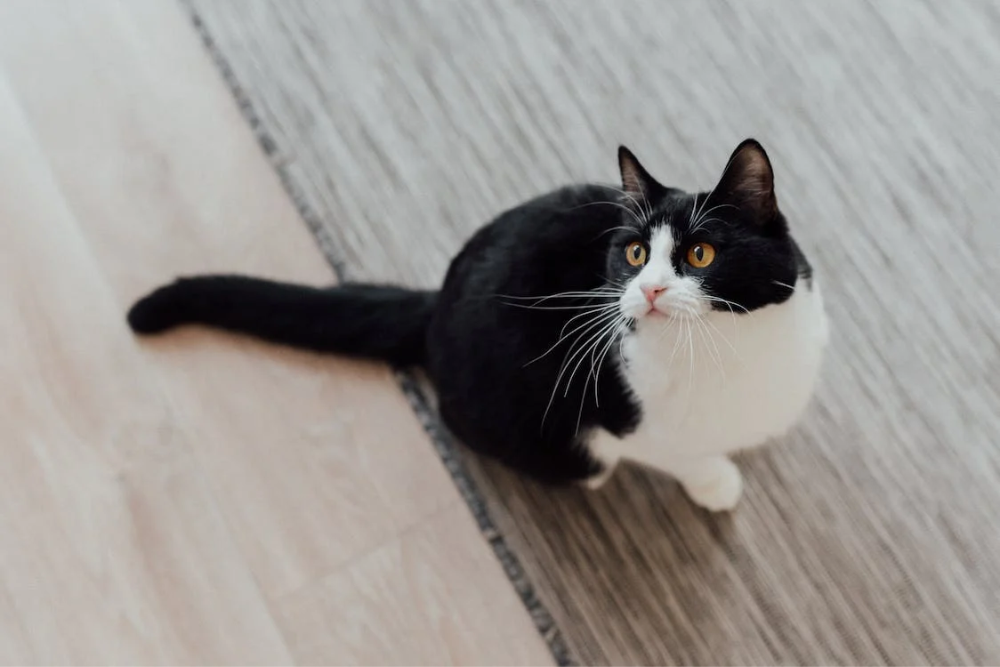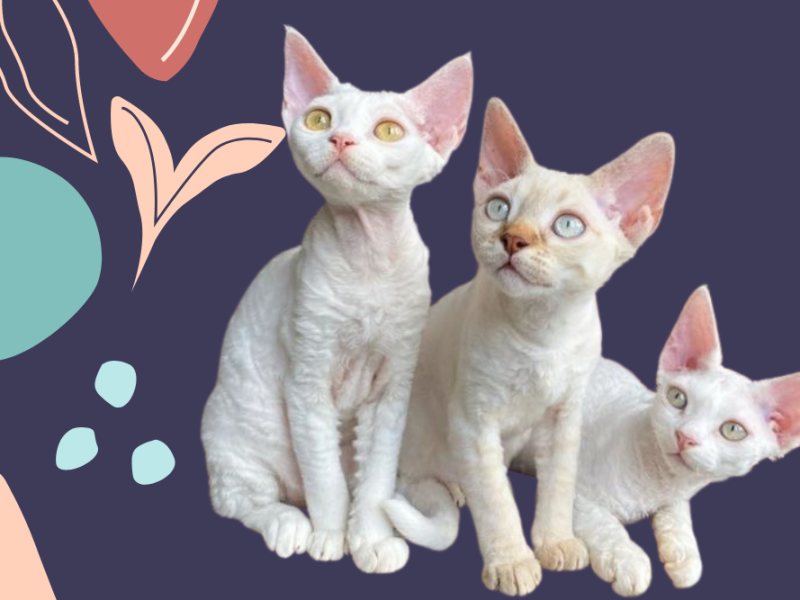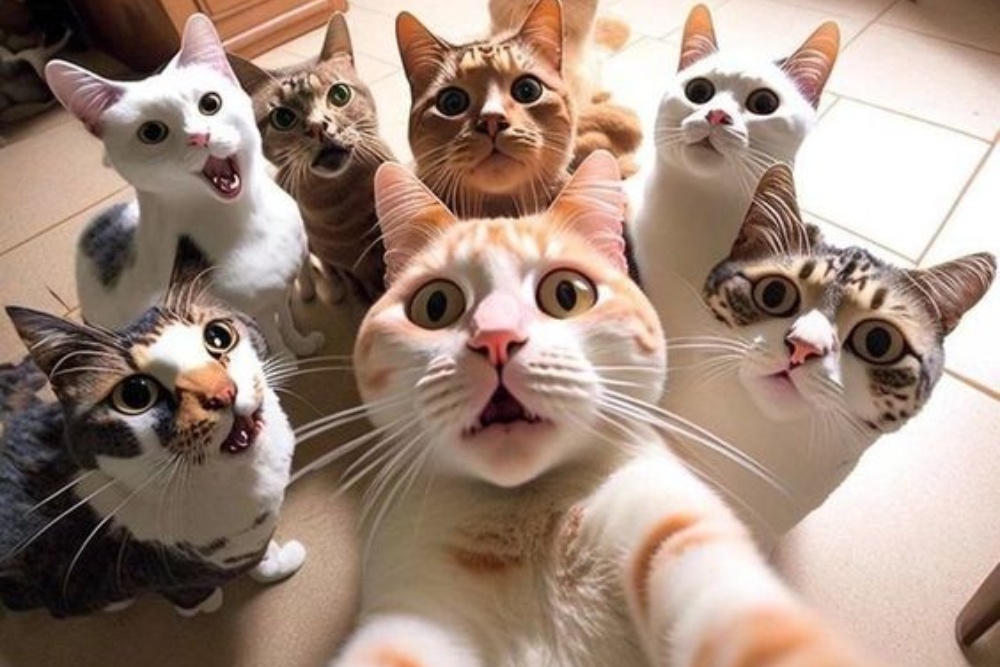Step into the sophisticated and charming world of tuxedo cats, where black and white elegance meets playful personalities. Tuxedo cats, with their distinctive coat patterns resembling formal attire, have enchanted cat lovers and enthusiasts alike. In this blog, we’ll embark on a delightful journey to explore the unique characteristics, behaviors, and fascinating history behind these dapper felines.
From decoding the genetics that create their stylish patterns to unveiling the diverse breeds that boast the tuxedo look, get ready to be captivated by the enchanting tales of these impeccably dressed four-legged companions. Whether you’re a seasoned cat aficionado or just starting your feline adventure, join us as we unravel the mystique and charm of tuxedo cats—one whisker at a time.
What Exactly is a Tuxedo Cat?
A tuxedo cat is a captivating feline characterized by its distinctive black and white coat pattern, resembling formal evening wear. Unlike a specific breed, the term “tuxedo cat” refers to the aesthetic appeal of this particular coat pattern, which has become synonymous with style and elegance in the world of feline fashion.
The Striking Black and White Ensemble
The hallmark of a tuxedo cat is its coat, typically black with white markings on the chest, paws, belly, and often the face. This unique pattern creates the illusion of a cat dressed in a tuxedo, complete with a black “jacket” and white “shirt” and accessories. The contrast between the dark and light fur adds to the cat’s charm and visual allure.
Crucially, being a tuxedo cat is not tied to a specific breed. Instead, it is a characteristic coat pattern that can be found in various breeds and mixed-breed cats. This inclusivity adds to the charm and diversity of tuxedo cats, as they come in different sizes, shapes, and temperaments.
What Defines the Tuxedo Cat Personality?
The personality of a tuxedo cat goes beyond its striking black and white coat pattern, adding an extra layer of charm to these fashionable felines. While certain characteristics may overlap with other cat breeds, tuxedo cats possess a unique blend of traits that make them stand out in the world of feline companionship.
Playful Elegance
Tuxedo cats are the embodiment of playful elegance. Their spirited nature is complemented by a sense of style, making them delightful companions for interactive play. Whether batting at toys, engaging in a game of chase, or showcasing acrobatic feats, tuxedo cats infuse every play session with a touch of sophistication.
Fashionable Curiosity
One distinctive trait of the tuxedo cat personality is their fashionable curiosity. These cats have a natural inclination to explore their surroundings with a curious and inquisitive spirit. Their curiosity often leads them to investigate new environments, objects, and even their human companions, making them engaging and entertaining pets.
Social Sophistication
Tuxedo cats are known for their social sophistication. They possess a friendly and sociable nature, making them adept at forming bonds with family members, including children and other pets. Tuxedo cats often enjoy being part of the action, whether it’s lounging with their humans or participating in family activities.
Expressive Elegance
With their distinctive coat patterns, tuxedo cats have an expressive elegance that extends beyond their physical appearance. These felines are known for their communicative behaviors, using meows, purrs, and body language to convey their feelings. Whether seeking attention, expressing contentment, or playfully requesting treats, tuxedo cats are skilled communicators.
Charming Mischief
Tuxedo cats carry a charming touch of mischief in their personalities. While generally well-behaved and affectionate, they may indulge in playful antics that keep their owners entertained. From cleverly batting at dangling objects to orchestrating surprise pounces, their mischievous streak adds an element of surprise to their charming repertoire.
Adaptable Elegance
Tuxedo cats exhibit an adaptable elegance that allows them to thrive in various living environments. Whether in a bustling household or a serene apartment, these cats adjust with ease, showcasing their versatility and ability to maintain their refined demeanor regardless of the surroundings.
Clever Elegance
The intelligence of tuxedo cats adds to their overall elegance. They are quick learners, making them adept at picking up tricks and commands. This cleverness, combined with their playful nature, allows for engaging interactions that stimulate both their minds and the minds of their human companions.
Tuxedo Cats: A Closer Look at Each Elegant Breed
Persian Tuxedo Cats

The Persian cat, known for its luxurious long fur, distinctive flat face, and large expressive eyes, exudes an air of royalty. Tuxedo markings on Persians highlight the contrast between the long, flowing black fur and the crisp white accents, creating a regal and elegant appearance.
Tuxedo Persians may evolve through the interplay of genetic factors. The piebald gene, responsible for the tuxedo pattern, interacts with the Persian’s naturally long and dense coat, resulting in the striking black and white ensemble.
Persians are renowned for their calm and laid-back demeanor. Tuxedo Persians often share this temperament, making them affectionate companions who enjoy lounging in luxurious surroundings.
Oriental Tuxedo Cats
Oriental cats, whether Shorthair or Longhair, are characterized by their sleek, slender bodies, large ears, and striking almond-shaped eyes. Tuxedo markings on Orientals add an exotic touch, combining grace and mystery in their appearance.
The distinctive tuxedo pattern may emerge in Oriental cats through a combination of genetic factors. The sleek and streamlined body of Orientals enhances the visual impact of the black and white markings.

Orientals are known for their vocal and interactive nature. Tuxedo Orientals maintain this trait, actively engaging with their human companions and expressing themselves through a range of vocalizations.
Norwegian Forest Cat Tuxedos

The Norwegian Forest Cat, with its sturdy build, tufted ears, and bushy tail, reflects a rugged charm. Tuxedo markings on this breed add a formal touch to their outdoorsy appearance, creating a unique and captivating blend.
Tuxedo patterns in Norwegian Forest Cats may arise through a combination of genetic variation and the interaction of the piebald gene with the breed’s thick, water-resistant coat.
Norwegian Forest Cats are known for their love of climbing and exploring. Tuxedo Norwegians maintain this adventurous spirit, thriving in environments that allow them to showcase their natural agility.
Maine Coon Tuxedo Cats
The majestic Maine Coon, recognized for its large size, tufted ears, and tufted paws, can also showcase the tuxedo pattern. The grandeur of this breed, combined with the striking coat, creates a captivating and eye-catching appearance.

Tuxedo markings on Maine Coons may develop through the interplay of genetic factors, enhancing the breed’s distinctive features. The contrast between the tufted ears and paws and the tuxedo pattern adds to their regal charm.
Maine Coons are sociable and affectionate. Tuxedo Maine Coons maintain these traits, forming strong bonds with their human companions and enjoying interactive play.
La Perm Tuxedo Cats

La Perm cats are celebrated for their unique curly coats and distinctive features. Tuxedo markings add a touch of whimsy to their appearance, creating a charming and individualized aesthetic.
The interplay of the piebald gene with the La Perm’s curly coat contributes to the emergence of tuxedo patterns. The curls and black and white markings create a visually dynamic and captivating combination.
La Perms are known for their affectionate and playful nature. Tuxedo La Perms maintain these qualities, making them delightful companions that enjoy interactive play and curling up in cozy spots.
Exotic Shorthair Tuxedos
The Exotic Shorthair, akin to the Persian but with a short coat, may display the tuxedo pattern. Their plush, rounded features, coupled with the striking coat, create an irresistibly charming look.

Tuxedo patterns on Exotic Shorthairs result from the interaction of the piebald gene with the breed’s plush and compact physique. The short coat accentuates the clear definition of the black and white markings.
Exotic Shorthairs share the calm and affectionate temperament of Persians. Tuxedo Exotics are known for their gentle nature, enjoying relaxed moments with their owners.
Devon Rex Tuxedo Cats

Devon Rex cats, recognized for their curly coats and large ears, may showcase the tuxedo pattern. The interplay of distinctive curls and the black and white markings adds a playful and unique touch to their appearance.
The tuxedo pattern in Devon Rex cats may emerge through the combination of genetic factors, accentuating the breed’s signature curly coat. The curls and markings create a visually striking and individualized look.
Devon Rex cats are known for their lively and mischievous nature. Tuxedo Devons maintain this playful spirit, engaging in interactive play and showcasing their unique charm.
British Shorthair Tuxedos
The British Shorthair, with its round face and dense coat, can occasionally have the tuxedo pattern. The combination of the pattern with the breed’s dignified features creates an air of sophistication.

Tuxedo patterns in British Shorthairs may result from genetic variations that enhance the breed’s distinctive coat. The dense and plush fur accentuates the contrast between the black and white markings.
British Shorthairs are known for their calm and easygoing temperament. Tuxedo British Shorthairs maintain this laid-back nature, making them wonderful companions for relaxed moments.
American Shorthair Tuxedos
Tuxedo markings are relatively common in American Shorthair cats. These versatile cats, with their moderate size and friendly nature, can showcase the tuxedo pattern with classic charm.
American Shorthair tuxedo patterns may arise through the interaction of the piebald gene with the breed’s adaptable and robust physique. The clear contrast in markings adds to their classic appeal.
American Shorthairs are known for their adaptability and friendliness. Tuxedo American Shorthairs maintain these qualities, forming strong bonds with their owners and adapting well to various living environments.
American Curl Tuxedo Cats
While not specifically known for the tuxedo pattern, American Curls can have various coat colors and patterns, including black and white. Their unique curled ears and the interplay of the tuxedo pattern add to their distinctive appearance.
The emergence of tuxedo patterns in American Curl cats may result from the combination of genetic factors and the breed’s distinctive curled ears. The curls and markings create a visually intriguing and charming ensemble.
American Curls are known for their affectionate and sociable nature. Tuxedo American Curls maintain these qualities, enjoying close interactions with their human companions and showcasing their unique physical features.
Exploring the world of tuxedo cats within each breed unveils a tapestry of unique features and characteristics. Whether it’s the regal elegance of a Persian, the playful charm of a La Perm, or the adventurous spirit of a Norwegian Forest Cat, each breed contributes to the diverse and enchanting realm of tuxedo cats.
Unraveling the Genetics: The Piebald Gene
The captivating black and white coat pattern seen in tuxedo cats is intricately tied to the fascinating world of feline genetics, specifically the presence of the piebald gene. Understanding the mechanics of this gene provides insight into the unique and stylish appearance of these charming felines.
What is the Piebald Gene?
The piebald gene is a genetic trait responsible for the distribution of color in a cat’s coat. In simpler terms, it determines where a cat will have color and where it will be white. Piebaldism is characterized by the presence of irregular patches of color on a predominantly white background, creating the classic tuxedo pattern.
How Does Piebaldism Work?
All cats carry genes for both colored and white fur. The piebald gene, when dominant, results in a cat having more white fur. In the case of tuxedo cats, this gene leads to the distinctive black markings on a predominantly white coat. The patches of black can vary in size and placement, contributing to the individualized appearance of each tuxedo cat.
Development of Tuxedo Patterns
The evolution of the tuxedo pattern through the piebald gene is a fascinating process. The gene regulates the migration of pigment-producing cells called melanocytes during embryonic development. When these cells don’t spread evenly, it leads to patches of color and, in the case of tuxedo cats, the iconic black markings.
The Role of Melanocytes
Melanocytes are responsible for producing melanin, the pigment that determines the color of a cat’s fur. In tuxedo cats, the concentration of melanocytes in specific areas creates the dark patches, while the areas with fewer melanocytes result in white fur.
While the piebald gene is associated with tuxedo patterns, the level of expression can vary. Some tuxedo cats may have bold and defined black and white markings, while others may exhibit a more subtle or diluted version of the pattern. This variability adds to the charm and uniqueness of each tuxedo cat.
Tuxedo Cats and Genetic Diversity
One of the remarkable aspects of the piebald gene and the tuxedo pattern is that it is not limited to specific cat breeds. Tuxedo markings can be found in various breeds, including domestic shorthairs, domestic longhairs, and specific purebred breeds such as Persians, Orientals, and Maine Coons.
The widespread occurrence of tuxedo patterns across different breeds highlights the rich genetic diversity within the feline population. It also showcases how certain genetic traits, like the piebald gene, can transcend breed boundaries, resulting in a captivating array of coat patterns.
Final Thoughts
From the regal Persians to the mischievous American Shorthairs, each tuxedo cat breed contributes its own chapter to the captivating tapestry of monochrome charm. As we celebrate their playful personalities, delve into the reasons behind their stylish patterns, and explore the unique traits of each breed, it becomes clear that tuxedo cats are more than just black and white—they’re the purr-fect blend of elegance and individuality. Whether you’re a dedicated cat enthusiast or a curious explorer of the feline world, may the tales of these enchanting black and white beauties leave pawprints of joy on your heart. Here’s to the timeless allure of tuxedo cats, where every whisker tells a story and every meow is a melody of charm. Until next time, may your days be filled with the magic that only these bewitching feline companions can bring.


